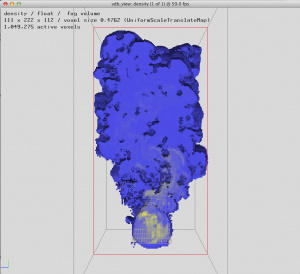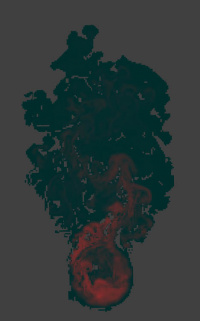「利用者:Jehuty/GSoC 2013/Results/Rendering VDB Volumes」の版間の差分
細 (1版 をインポートしました) |
|
(相違点なし)
| |
2018年6月29日 (金) 06:04時点における最新版
目次
Results - Rendering VDB Volumes
This project was necessarily experimental since volume shading isn't available yet for the Cycles renderer. However, the project envisioned considerably more than was delivered, so here's a summary:
The promise: What we hoped we'd have
- Reading from and writing to VDB files - basically, importing and exporting volumetric data;
- 3D texture lookup on the VDB volumetric data, to be rendered by Cycles;
- Creation of a Cycles node for the handling of VDB data and metadata;
- Tentative motion blur support (filtered lookup);
The reality: What actually got done
- Reading from a VDB file - file path must be provided to an OSL shader, so it can be passed for lookup;
- 3D texture lookup, with some interpolation woes, as discussed below;
Texture Lookup: Interpolation and Sampling
Two modes of texture lookup on VDB structures were implemented:
(i) a naive one, obtaining the value of an individual voxel at a time, with no cache, without a choice of interpolation method, in which the queried point is transformed to the nearest discrete coordinates in the volume space (essentially, a neearest neighbor approach). Problems are the lookup is slower, and the resulting image is significantly blocky, but otherwise, the lookup works as expected.
(ii) a more sophisticated alternative, obtaining values with the help of an accessor class, which has a cache, and supports three interpolation methods, namely nearest neighbor, trilinear and quadratic. Results are smoother, but for reasons I don't yet fully understand, the sampling process isn't incremental as I expected, and, as a result, the final image is often worse than unfinished renders. I'm still working on a solution, and will comment on my findings even after the program is over.
One example is shown below, rendering the Smoke.vdb texture (file can be found here) on a plane. In effect, what we see is a slice of the volumetric data. On the left, the texture is shown against a plane using the VDB Viewer utility, and on the right, the same file, as rendered on the Blender viewport.
What's Next
Despite the end of the Summer of Code program, I will continue working on volumetric rendering with the Cycles renderer, and I intend to complete the integration of the OpenVDB, adding the missing features, so it can be usable when shading also gets done.

